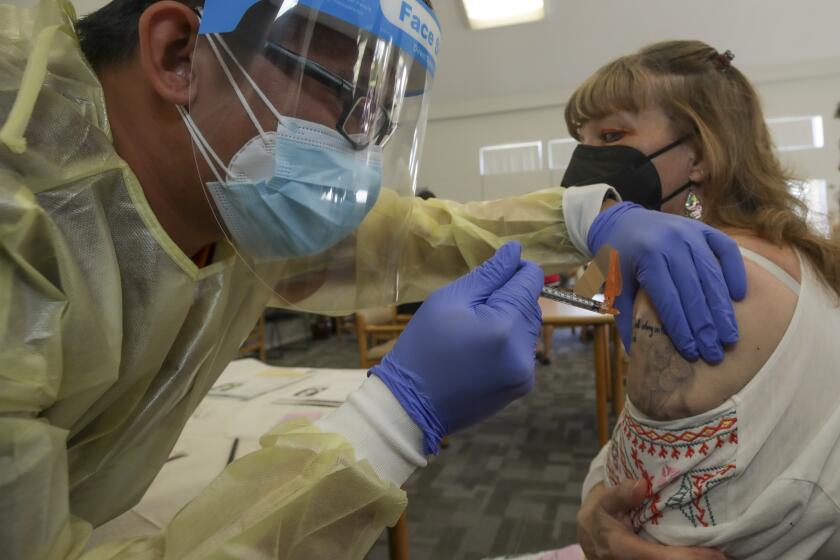
- Share via
LA JOYA, Texas — The 10-year-old boy crossed the Rio Grande with hundreds of other migrants last week. But he was essentially alone.
That is how Christopher Garcia says he managed to travel to the U.S. border over the course of three months from his home in one of the world’s most dangerous cities — San Pedro Sula, Honduras — without an adult: by blending into groups of older children and families.
Christopher, a skinny athletic boy with curly brown hair and an impish smile, departed at an age when street gangs that dominate his neighborhood had started to recruit him. His father, who worked at a clothes factory, had tried to migrate to the U.S. himself in the past but was deported the same day he crossed the border.
This year, the family’s fortunes worsened after hurricanes damaged their home, knocking trees onto the roof.
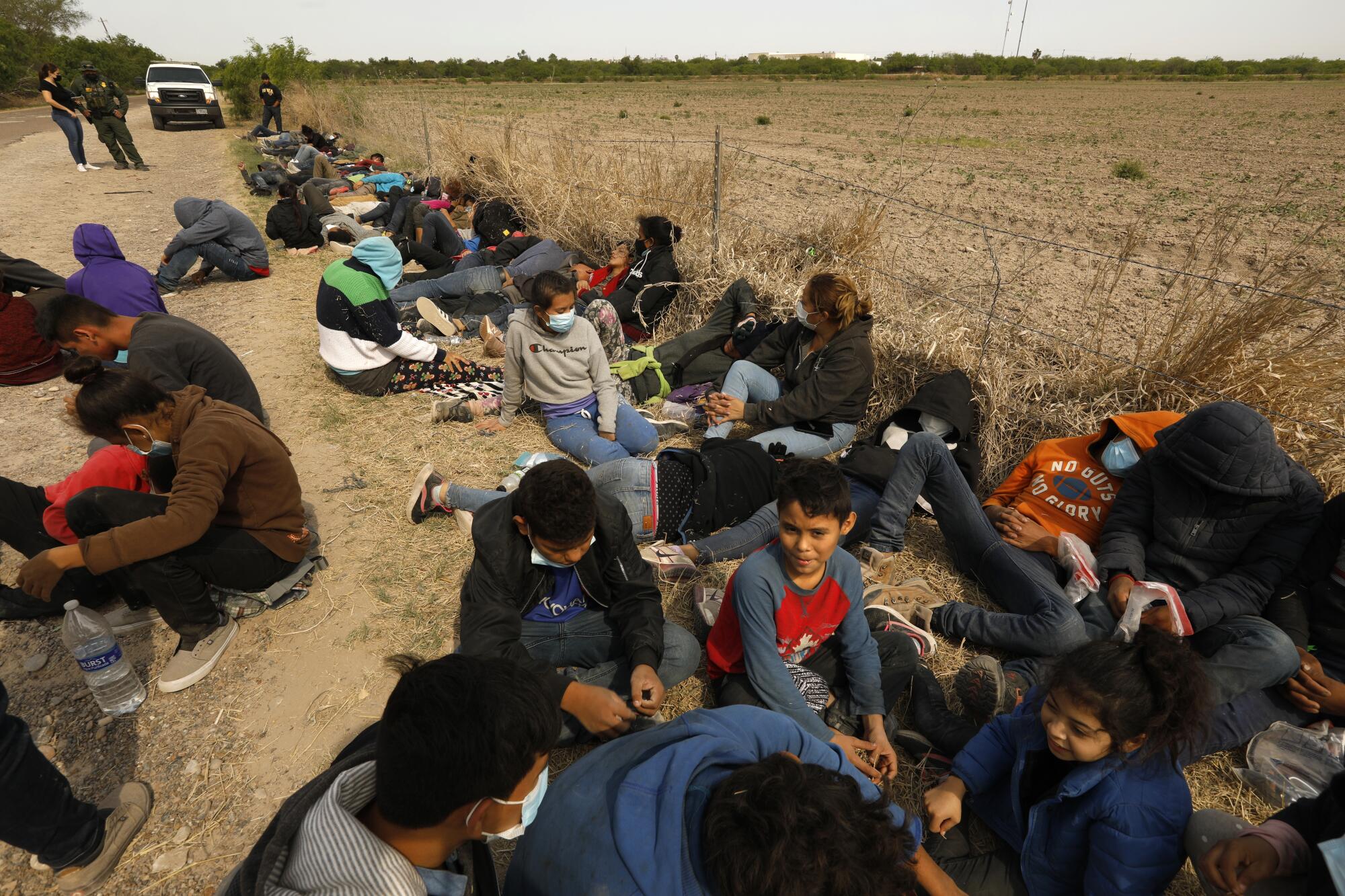
So, Christopher said, he left his parents and two younger sisters and headed to join his great-aunt, a U.S. citizen, in the mountains of western North Carolina. He carried her phone number with him, written on the back of his Honduran birth certificate. As he made his way north toward Texas, he managed to memorize the phone number, just in case he lost his paperwork or was robbed.
Last week, a Mexican smuggler on the south side of the Rio Grande took Christopher to an abandoned house where he slept on the floor with other migrants for three days. He waited, shivering, without a coat, food or running water. The smuggler returned late Wednesday of last week and led Christopher’s group of 700 migrants to the river, where he said he heard gunfire — he didn’t see who was shooting. They crossed on rafts to Texas’ Rio Grande Valley about midnight.
“I’m so hungry. I want food. I want to take a bath, change my pants.”
— Christopher Garcia, 10 year old traveling alone to the U.S. from Honduras
Once on the U.S. side in rural La Joya, Christopher wandered with the group in the dark through thick mesquite brush lining the river, splitting up into smaller factions until they found Old Military Road. The cracked, backwoods artery of the Rio Grande Valley is frequented by U.S. Customs and Border Protection. Border Patrol agents spotted Christopher’s group of 27 youths and seven adults early that Thursday, March 25. Agents sat them down in the dry grass and called for a bus to take them to a temporary holding area, which was already overcrowded. But all the buses were busy transporting other migrants.
“We’re already full to capacity,” one of the agents said as he waited with the youths by the side of the road.
Due to a sharp increase in migration on the U.S.-Mexico border, it took nearly 12 hours for the buses to arrive. Christopher was among more than 171,000 migrants who were taken into custody on the southern border last month, the highest monthly total since 2006, according to preliminary Customs and Border Protection data verified by The Times.
Of those migrants, more than 18,800 were youths like Christopher who arrived without adults, far more than the previous monthly record high of 11,861 in May 2019. About a third of them last month were taken into custody in the Rio Grande Valley.
It would be days before Christopher spoke with relatives in the U.S.
Wet sweatshirts. Toddler shoes. A line of Scripture. These are some of the things left behind by migrants making their way across the Rio Grande.
The same day Christopher arrived in the U.S., President Biden said his administration was attempting to swiftly release child migrants to shelters and, ultimately, to their families.
“We’re building back up the capacity that should have been maintained and built upon that [President] Trump dismantled,” Biden said during his first news conference, adding that once a youth arrives at the border, relatives are contacted within 24 hours and vetted.
But families, like Christopher’s in the U.S., said they face delays trying to find and claim migrant youths held by the federal government.
The Border Patrol had 5,381 migrant youths in its custody, and 13,359 more were in federal shelters as of Thursday,the most recent figures released. The increase in youths has overwhelmed the Border Patrol, which faces shortages of buses, holding areas and shelter beds.
This level of coverage, though far short of herd immunity, provides some defense against the COVID spikes seen elsewhere in the U.S., officials say.
On March 25, agents waited with Christopher’s group in the afternoon heat with no food, little shade and water. Some of the girls were pregnant. One passed out and had to be revived by agents.
Christopher had dreamed of going to the movies in the U.S., maybe even Disneyland. Now he, too, was exhausted.
“I’m so hungry,” he repeated, brushing off his dusty clothes. “I want food. I want to take a bath, change my pants.”
He recalled how his parents had instructed him to survive.

“They said if I was hungry to suck my fingers,” he said, but that didn’t work.
Mid-morning, a Frito-Lay truck stopped near the group, and the driver handed agents a few bags of Cracker Jack. Agents distributed the snacks to the youths, who asked for water. An agent told them to line up behind a cooler in his SUV and passed out paper cups, one for each child.
“Where are the little kids?” the agent asked.
Christopher went to the front of the line, along with two Honduran 9-year-olds, a girl named Litzy and a boy named Snyder.
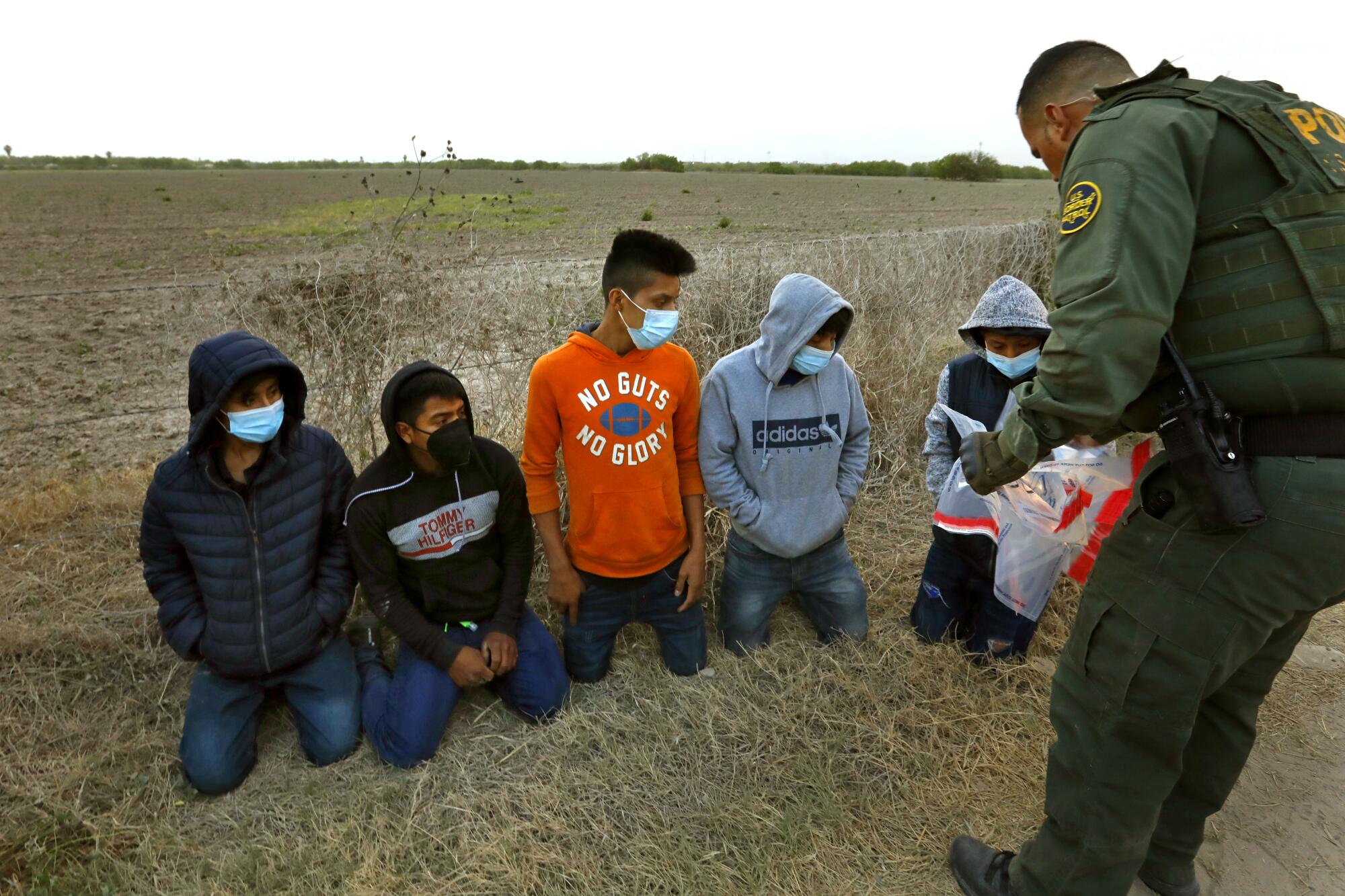
Christopher wore a red and blue shirt that featured a skier and the motto, “Time 2 Shred.” Back home, he played soccer and basketball. Now his right leg was cramping. He winced, rubbing it above his sneakers, which he wore without socks. Nearby, a 16-year-old boy was limping, injured during the river crossing.
“I suffer,” Christopher said. “But just a little.”
Another boy had a cellphone with video games the children took turns playing. Some talked about their relatives in Kansas, Florida, Tennessee and Texas.
About 1:30 p.m., a white government bus finally arrived, then a half-dozen more. Christopher stood and fidgeted as agents called youths’ names and they boarded. He was among the last called. Single adult migrants boarded a separate van and would probably be sent back to Mexico.
Christopher and the rest of the youths, as well as some migrant families, were driven to a Border Patrol holding area in nearby Donna, Texas, where conditions were dire. Severely overcrowded, the tent facility designed for 250 people already held about 4,000, including 3,300 youths who had arrived without adults. Some had already spent weeks there, waiting to be released to their families.
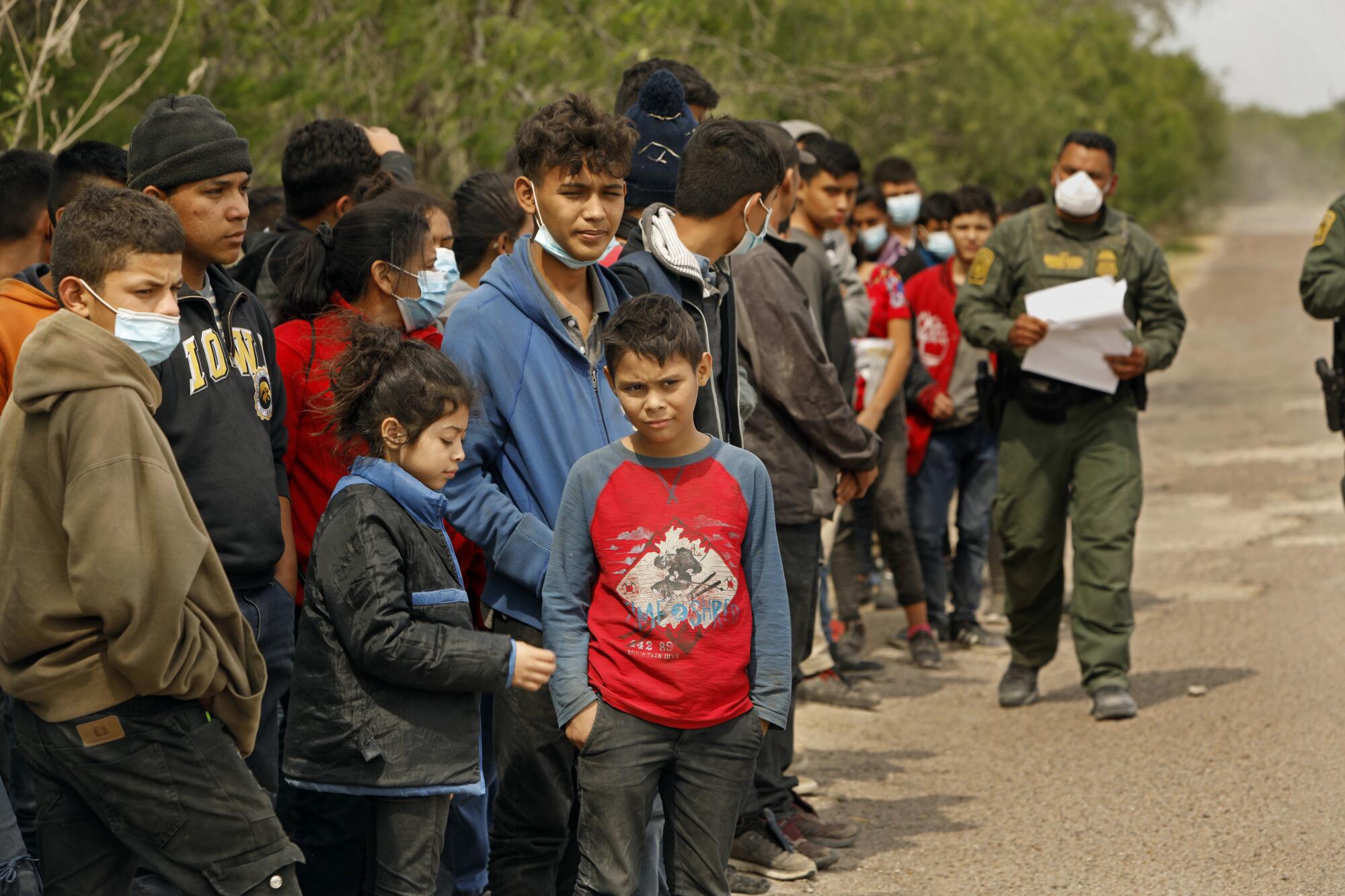
On Tuesday, select pool reporters were allowed to spend less than two hours inside the facility, where footage showed Christopher was still being held five days after crossing the border. Video recorded during the visit showed Christopher filing through a meal line, taking a Capri Sun drink pouch and entering a crowded housing “pod,” still wearing the same red and blue shirt he arrived in.
By law, the Border Patrol is supposed to transfer youths within 72 hours to Department of Health and Human Services shelters with beds, medical staff, teachers and recreational activities. But due to the uptick of migrants, more than 2,000 youths had been held at the Donna facility longer than 72 hours as of Tuesday; 39 had been held for more than 15 days, and some for up to 20 days, said Oscar Escamilla, acting executive officer of the Border Patrol’s Rio Grande Valley sector.
“A Border Patrol facility is no place for a child.”
— Homeland Security Secty. Alejandro Mayorkas
The facility costs $16 million a month to operate, excluding medical services and caregiver contracts, he said. Medical staffers check youths for lice but none are tested for the coronavirus unless they’re symptomatic, Escamilla said. Youths are issued wristbands with bar codes showing medical conditions and when they last showered. Youths 14 and older have their photos and fingerprints taken, and all receive notices to appear in immigration court, Escamilla said.
Youths were housed in 400-square-foot “pods” designed to hold 32 people during the pandemic but crowded with hundreds, one packed with 676 youths. They could be seen sleeping under silver Mylar blankets on pads spread across the floor. Escamilla said about 14% of youths test positive for the coronavirus when they leave, and he expects some get infected in the packed pods.
The Border Patrol set up a playpen outside the pods where an 11-year-old boy attended to his 3-year-old sister; a 17-year-old who had migrated without an adult cared for her newborn. “I can’t possibly put these young kids in those pods because they’re going to get hurt,” Escamilla said.
Outside, construction equipment hummed as workers expanded the facility, roughly doubling its size with new tents that will be overseen by Health and Human Services.
Border Patrol agents are supposed to ask youths if they have a contact in the U.S. and allow the child to speak with them, Escamilla said — the press tour showed youths in spaces labeled “phone rooms.” But Christopher’s relatives still had not spoken with him as of Tuesday, nor had relatives of some of the other children detained with him.
“A Border Patrol facility is no place for a child,” Homeland Security Secretary Alejandro N. Mayorkas said in a statement this week. “We have been working around the clock, in coordination with HHS, to quickly move unaccompanied children out of these crowded Border Patrol stations.”
On Wednesday, Mayorkas held a conference call with Health and Human Services Secretary Xavier Becerra and other officials to discuss the situation on the border, reassuring members of Congress that the administration was making progress. Rep. Henry Cuellar (D-Texas), who was on the call and had visited the Donna facility Tuesday, disagreed.
“They said, ‘We’re moving kids as soon as possible.’ I didn’t see that,” Cuellar said in an interview afterward, noting that he saw filing cabinets at the Donna facility overflowing with thousands of case files of migrant youths awaiting release to their families.
“When someone makes the decision to take the risk for a better life, for our children, to send them alone, it’s because there’s no other way.”
— Norma, 37, who works in construction
Border Patrol agents told Cuellar that of those held at the Donna facility, 1,800 were boys and 1,500 were girls. About 800 were younger than 13. Three dozen youths had been held for more than two weeks. Four adolescent boys and three adolescent girls had been held for more than 19 days, he said, in part due to a shortage of federal shelter beds. On Thursday, the Border Patrol would encounter 496 newly arrived migrant youths, but federal shelters would discharge only 288.
“They’re not moving out fast enough,” Cuellar said of youths in federal facilities.
He said some adolescent girls held for more than 20 days in Donna have since been sent to a shelter for girls that opened last week at the San Diego Convention Center. Federal officials have opened a slew of new shelters and are considering more in California, mostly for adolescent boys, who usually migrate in larger numbers.
“I asked Border Patrol, ‘Why are they taking boys over girls?’” Cuellar said, especially when some girls have waited weeks to get released. “I feel bad for those little girls, especially the young moms.”
It takes at least a month for federal caseworkers to vet family and other sponsors allowed to claim migrant children, Cuellar said, and if they can’t find a sponsor, the process can take up to four months.
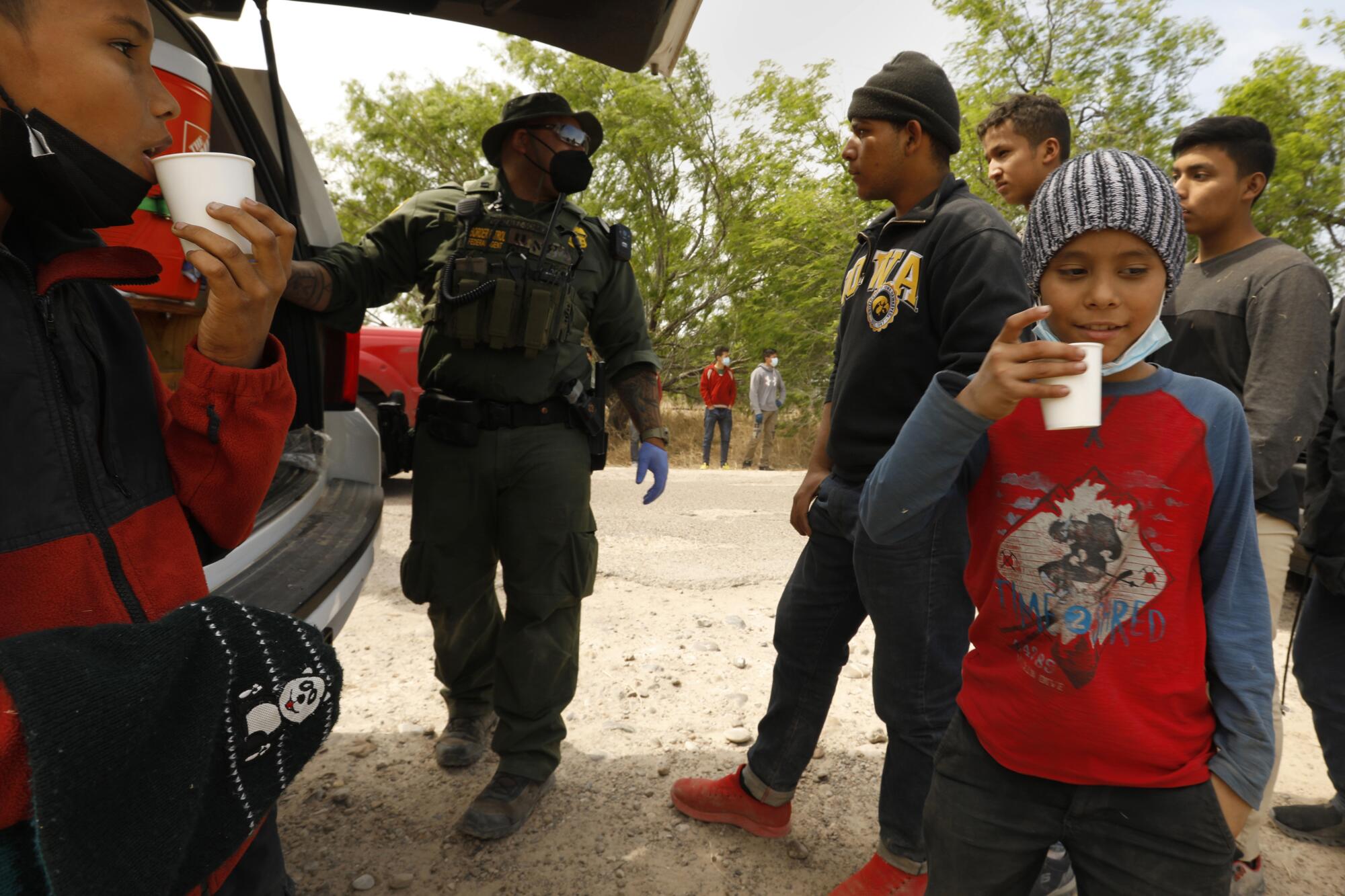
“The problem is compounding with every kid that they put into detention,” said Dr. Amy Cohen, whose Los Angeles-based nonprofit organization, Every Last One, works to reunite migrant children with their families, including children who arrive at the border without adults. “What you’re seeing is more and more delays, and it’s only going to get worse. We’re warehousing them.”
The mother of Snyder, a 9-year-old Honduran migrant who crossed the river with Christopher, said the Border Patrol called her in Florida on Sunday to say they had him, but federal officials have yet to follow up with her.
The mother, Norma, 37, who works in construction, asked to be identified only by her first name because she’s living in the U.S. illegally, which does not bar her from claiming her son. She had a relative bring Snyder to the border to cross alone after his school closed due to the pandemic, the country’s economy was devastated by hurricanes and she feared he would be pressured to join a gang.
“When someone makes the decision to take the risk for a better life, for our children, to send them alone, it’s because there’s no other way,” she said.
A Guatemalan youth who arrived in the same group as Christopher, 16-year-old Frank Echeverria, was also still waiting Thursday to join relatives in Arkansas.
“I don’t know why it’s taking so long. I wish he would be able to call us,” stepmother Lisa Castillo, a U.S. citizen, said by phone. “What is it we can do to get him faster? We’re willing to do anything. His family’s waiting on him. We’re really worried about him and we’re wanting to have him home with us.”
Christopher’s great-aunt in North Carolina has been trying to claim him since the Border Patrol contacted her on March 25.
“I’m worried about how can I get him from there,” said Digna Brittain, 60, a housekeeper in Morganton, N.C. “They told me an official was going to call me, and I have my phone in my hand. I will happily buy him a ticket here.”
She said she sent Christopher’s mother, her sister’s daughter, a photo released by the Border Patrol of Christopher in the Texas holding area. His mother said he was wearing the same shirt he had left home in months before. She had called to alert Brittain after he left, explaining that he was coming to escape gangs.

“That’s why parents send their children here, rather than risk their lives in the street. They reach a certain age and they recruit them for the gangs,” Brittain said. “The parents have to risk it because they think less will happen to them in the U.S.”
It’s been 25 years since Brittain left Honduras. She last saw Christopher, she said, when she returned to visit her mother a few years ago. Now a U.S. citizen, she plans to adopt him.
“I don’t want him to go to a shelter because he has family here, me and lots of cousins,” Brittain said.
On Wednesday, after she called a federal hotline, Brittain was told that Christopher was still in Texas and that someone would call her in a couple of days to explain how he would be released. Then officials put Christopher on the phone, and she sobbed with relief.
“He told me that he’s good, only he’s bored to be there,” Brittain said afterward. “For him, to be eating and feel safe is a lot.
“My husband wants us to go get him, but I know there’s a process we need to follow,” she said.
As of Saturday, more than a week after he crossed the border, she said Christopher remained in federal custody.
More to Read
Sign up for Essential California
The most important California stories and recommendations in your inbox every morning.
You may occasionally receive promotional content from the Los Angeles Times.


